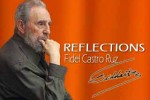 Some days ago, on May 28, the violent battle waged at El Uvero was commemorated with well deserved references. An elemental duty forces me to clarify the facts.
Some days ago, on May 28, the violent battle waged at El Uvero was commemorated with well deserved references. An elemental duty forces me to clarify the facts.
During those weeks, Manuel Piñeiro, “Red Beard”, as the leopard, who never changes its spots, as the saying goes, managed to send to Santiago de Cuba a truckload of weapons that were associated to the attack against the Presidential Palace by the Revolutionary Directorate. Somehow he had managed to take hold of them. Frank País, who was the national actions chief of our “26 of July Movement”, sent a significant part of that cargo to the troublesome zone of the Sierra Maestra, where our incipient Rebel Army was rising alive from its ashes.
That learning period had been extremely tough. Step by step we started to gain our first victories, through which we were able to increase our strength in weapons and men without suffering any casualty. We were also forced to cope with the dangerous treason perpetrated by Eutimio Guerra, who had been a rebel peasant until the moment when he yielded to the bountiful offers made by the enemy. Despite all obstacles and with the support of the men and means sent by Frank we began to create the first guerrilla detachment with a vanguard that was headed by Camilo; a rearguard that was commanded by Efigenio Ameijeiras; the centre forces made up by small platoons and the General Command. We already had a group of seasoned fighters who had conveniently adapted to the conditions of the theatre of operations when we received a significant cache of weapons that were rescued by “Red Beard” and had been conveyed to us hidden inside some barrels filled with thick grease.
Was it correct, from the military and revolutionary points of view, to attack the entrenched and well armed garrison close to the seashore, in the same place used to ship the timber extracted from that area? Why did we do so?
It so happened that at that time, on the month of May, the “Corynthia” expedition had already landed, headed by Calixto Sánchez White. A strong feeling of solidarity made us launch the attack against the military garrison at El Uvero.
In full honesty I should say that the decision adopted, leaving out the merit of the solidarity it entailed wasn’t in the least correct. Our role, which prevailed over any other goal, just as had been the case throughout our entire revolutionary life, was not in accordance with that decision.
I remember the first gunshot I made with the telescopic sight rifle that I had, aiming to the radio communication equipment of the garrison. After that shot, tens of bullets were fired against the enemy command post. That was why the adversary did not know that its garrison was under attack. Thus, at least for three hours neither bombs nor shells were shot against us, something that usually happened, without exception, hardly 20 minutes after the beginning of every battle. Without the presence of these factors, it was quite likely that this decision, which was only inspired by solidarity, would have reduced our troops of almost one hundred veterans, in which case we would have had to go through the same hazardous journey all over again, something that would have been for us the best case scenario.
It was under such circumstances that Almeida was shot in the chest; he was spared from a far more serious wound thanks to something made of metal that he was carrying in his pocket, as he remembered. Guillermo García, wearing a helmet he found for himself in the first combat, waged a hard-fought battle with the defender of a fort made of thick logs. Che, who was shooting with a machine gun that usually got jammed, left his position in order to engage those who were fighting Almeida. And Raúl moved on with his small platoon to fight the soldiers who entrenched themselves among the piles of logs that were ready for shipment. All this happened before the fighter bombers came into the scene. Julio Díaz, a courageous fighter who was shooting with a tripod, could not advance any further. He was lying by my side with a deadly gunshot in his forehead.
Is there a better understanding now about what happened on May 28, 1957, 55 years ago?
Fidel Castro Ruz
June 1st, 2012
4:36 p.m.
 Escambray ENGLISH EDITION
Escambray ENGLISH EDITION




Escambray reserves the right to publish comments.